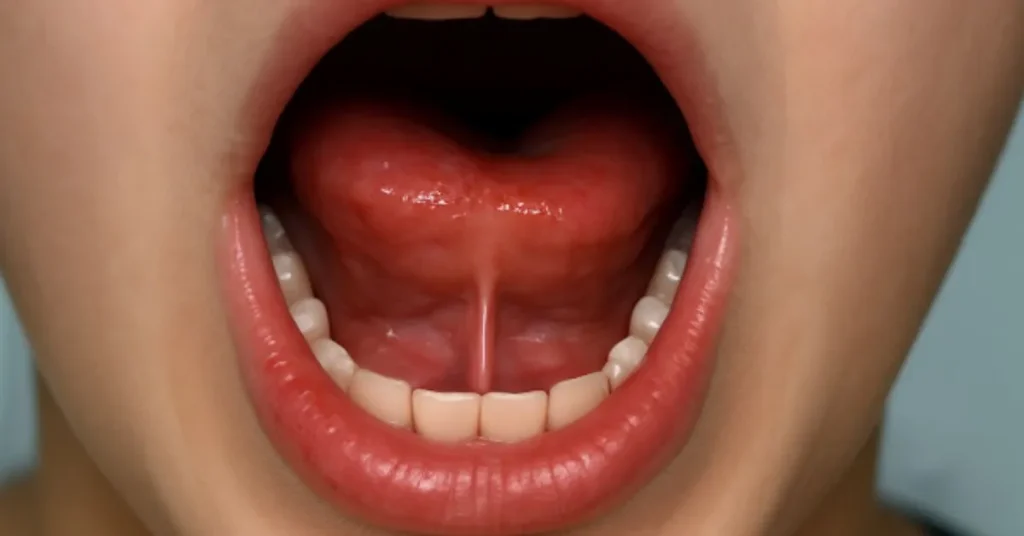A Guide to Lip and Tongue Ties in Children and in Adults
Around 4% to 11% of newborns are estimated to be born with tongue ties, a condition that can affect feeding, speech and oral development. Many go unnoticed in early life, only to surface later during childhood or even adulthood.
Tongue ties and lip ties happen when the thin tissue under the tongue or upper lip is too tight or thick, restricting movement. This guide explains what they are, how they affect children and adults, and what can be done to treat or manage them.

What Are Tongue and Lip Ties?
Tongue ties (also known as ankyloglossia) occur when the lingual frenulum, the band of tissue under the tongue, is too short, thick or tight. This limits the tongue’s ability to move freely.
Lip ties are similar. They involve the tissue (labial frenulum) between the upper lip and the gum. In both cases, restricted movement can cause issues with feeding, speech, oral hygiene and more.
Tongue ties may be mild and barely noticeable or severe enough to interfere with daily tasks such as eating and speaking.
How Do Tongue Ties Affect Babies and Children?
In infants, tongue ties can lead to feeding problems. A baby with restricted tongue movement might:
- Struggle to latch while breastfeeding.
- Tire quickly or feed for long periods.
- Swallow excess air, causing gas and fussiness.
- Gain weight slowly.
For mothers, this may cause nipple pain, blocked ducts or reduced milk supply. Further, as children grow, untreated tongue ties can lead to:
- Delayed speech or unclear pronunciation.
- Difficulty chewing or swallowing certain foods.
- Problems with oral hygiene, as the tongue may not reach all areas.
- Mouth breathing or poor dental development.
Lip ties may also cause a gap between the front teeth or contribute to tooth decay due to food trapping.
Signs to Look for in Young Children
Early signs of tongue ties often include:
- Clicking sounds during feeding.
- Poor weight gain.
- Gumming or chewing on the mother’s nipple during breastfeeding.
- A heart-shaped or notched tongue tip.
In toddlers and older children, signs can include:
- Trouble forming certain sounds like “t,” “d,” “l” or “r”.
- Messy eating.
- A preference for soft foods.
- Difficulty licking an ice cream or moving food around the mouth.
Parents may also notice frustration during speech or an unusual tongue posture at rest.
Tongue Ties in Adults: A Hidden Problem
Not all tongue ties are caught early. Some remain undiagnosed into adulthood, where they may
contribute to:
- Speech difficulties.
- Jaw tension or discomfort.
- Snoring or mild sleep apnoea.
- Ongoing dental issues.
- Problems with kissing or oral activities.
- Tightness in the neck, shoulders or upper back.
Adults with tongue ties often report that their tongue feels “held back” or limited in range. Many adapt over time, but some choose to seek treatment later in life for improved comfort and function.
Diagnosis and Assessment
Tongue ties are usually diagnosed through a physical exam. A healthcare provider may:
- Observe the range of tongue or lip movement.
- Ask about feeding, speech or eating concerns.
- Use screening tools to assess severity.
In babies, both a lactation consultant and a paediatric dentist or doctor may be involved. In older children and adults, dentists, speech therapists or ENT specialists often make the assessment.
The condition can vary greatly in presentation, so what’s obvious in one person may be subtle in another.
Treatment Options: To Release or Not to Release?
The main treatment for tongue ties is a procedure called a frenectomy, where the tight tissue is snipped or medically lasered to allow for greater movement. It is quick and usually done under local anaesthetic.
In babies, the release is often followed by breastfeeding support to help improve latch. In children and adults, therapy may be needed after the procedure to retrain muscles and speech patterns.
Not every tongue tie needs treatment. Mild cases that don’t interfere with function can be left alone. A full assessment helps guide the decision.
Benefits of Treatment
Releasing a tongue or lip tie can:
- Improve feeding in babies.
- Reduce discomfort for breastfeeding mothers.
- Support clearer speech in children.
- Help with oral hygiene and ease of eating.
- Improve posture and reduce muscle tension in adults.
- Support better airflow and sleep in some cases.
Outcomes vary by age and severity. In most cases, the earlier the treatment, the quicker the adjustment and recovery.
Therapy and Aftercare
For children and adults, post-release therapy is often important. This may involve:
- Myofunctional therapy to retrain tongue and mouth muscles.
- Speech therapy to correct sound formation.
- Bodywork like physiotherapy or chiropractic care to release tension patterns.
Babies may also need guidance from lactation consultants to help them relearn how to latch and suck effectively.
Exercises are often given to help the tongue heal in its new range. Without follow-up, the tissue may reattach or heal in a restricted way.
When to Seek Help
If your baby struggles to feed, gains weight slowly or shows signs of oral discomfort, it’s worth getting checked.
In older children, concerns about speech clarity, picky eating or mouth breathing may also point to a possible tie.
Adults who experience tightness, speech strain or chronic oral tension might benefit from an assessment too.
Trust your observations. While some issues seem minor, they can have wide-reaching effects over time. A simple examination from us could offer clarity and peace of mind.
Tongue Ties and Holistic Health
Tongue function connects to breathing, sleep, posture and even digestion. That’s why more health providers are taking a holistic view of tongue ties. It’s not just about speech or feeding — it’s about overall wellness.
In many cases, correcting a tie opens the door to better habits, easier movement and more comfort across the body. When managed well, even a small change in tongue mobility can create a big shift in daily life.
Tongue ties and lip ties may seem like small issues, but they can shape how we eat, speak, sleep and feel, from birth to adulthood. Catching and treating them early makes a real difference in comfort and function. But even when noticed later, support and simple procedures can restore ease and balance.
By understanding how tongue ties affect the body and knowing what to watch for, parents and adults can make informed decisions that support long-term health and wellbeing. Need professional advice on dental issues such as lip and tongue ties and more? Schedule an appointment with Rouse Hill Smiles Dental Care today.
Our Principal Dentist
Dr. Teena and the Rouse Hill Smiles team are dedicated to providing patients of all ages with the highest quality of care.

Dr. Teena Bali
Dentist
Quick Contacts
- Rouse Hill Plaza G07-G08, 2-4 Aberdour Avenue Rouse Hill, NSW 2155
- enquiries@rousehillsmilesdentalcare.com.au
- (02) 8320 0548
- Copyright 2025 Rouse Hill Smiles Dental Care







